
© 3d_vr - stock.adobe.com
Adhesives for laboratory furniture
Professional laboratory furniture is usually expensive custom-made products and is subjected to extreme stress on a daily basis due to its intended use. Since they make a significant contribution to occupational safety in everyday laboratory work, some laboratory furniture is subject to statutory regulations.
To meet this challenge, the use of the right adhesive is crucial. The adhesive is used for surface lamination, edge bonding and dowel bonding/cabinet bonding. Furthermore, assembly bonding is carried out with appropriate adhesives. In the laboratory area, the following requirements, among others, apply to an adhesive bond:
-
High impact and scratch resistance
-
High load capacity
-
Chemical resistance
-
Water resistance
-
Steam resistance
-
Heat and cold resistance
-
Fire resistance
For laboratory furniture, we clearly rely on reactive PUR hotmelt adhesives. They offer by far the highest resistance to heat, chemicals, moisture and mechanical stress. Reactive PUR hotmelt adhesives can be customized, which enables a customer-oriented application and also guarantees an uncomplicated and economical manufacturing process.
The demand for environmentally friendly and low-emission adhesives is constantly increasing. We therefore offer low-emission PUR hotmelt adhesives for the laboratory sector.
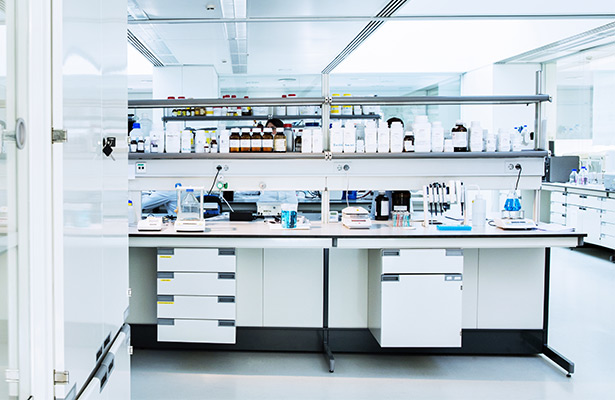

© Chris Ryan/KOTO - stock.adobe.com
Adhesives for 2D surface lamination of laboratory furniture
Extremely robust, shock-proof and aesthetic furniture surfaces are a basic requirement in laboratory environments. For this reason, decorative materials are glued to carrier boards, and both the decor material and the adhesive must withstand the demands of day-to-day laboratory use. The bonds must have strong and permanent resistance to various chemicals, cleaning agents, different temperatures, water, steam, and high impacts to ensure long-lasting use.
The FlatLamination process ensures efficient and fast production of the furniture units. First, the hotmelt is applied to the whole surface of the carrier board with heated rollers. Then the coating material is added, also with rollers and using pressure. Reactive hotmelts offer the best benefits for this purpose. Their formulation can be customized to specific production processes, which is ideal for industrial processing. Long open times combined with a high initial strength provide flexibility and mean that the furniture boards can be further processed immediately after bonding. Further advantages are very high final strength and great resistance to external factors. A brilliant finish can be achieved even with very thin films.
Boards laminated in a FlatLamination process can be used for the following furniture elements:
-
fronts
-
sides
-
rear panels
-
shelves
Our chemical engineers and scientiests are committed to researching new adhesive formulations and processing methods to achieve improved bonding and processing properties. We specialize in providing customized adhesive solutions for smooth automated production processes. With decades of experience in surface lamination to draw on, we continue to solve many a complex challenge. Benefit from our know-how and let us advise you.
Contact us directly by e-mail or phone.
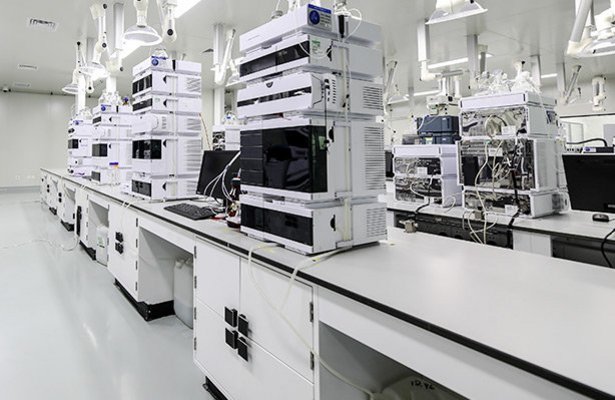

© Unique Vision - stock.adobe.com
Edge banding for laboratory furniture
The edges of particle boards that serve as carrier materials are very fragile. Should any liquid or steam, etc., get spilled on unprotected edging, the latter will swell and, sooner or later, ruin the whole piece of furniture. Edge banding is therefore essential. Protecting furniture edging in laboratories can be challenging. The furniture is constantly exposed to special cleaning agents, heat and steam, and has to withstand above-average shock impacts. The quality of the edge banding is therefore decisive for the durability of a product used in such an environment.
State-of-the-art edge banding machines are used for edge banding laboratory furniture. Any adhesives used have to meet very stringent requirements as the production line processes are becoming ever faster and more customized. Reactive PUR hotmelts are unbeatable for such purposes. High initial strengths mean that direct further processing is usually possible. The formulation of the adhesive can be customized to the specifications of both the end product and the production process, thus contributing to efficiency all along the line.
We cooperate closely with established manufacturers of edge banding machines, and our edge banding adhesives have been used for several decades in industrial laboratory furniture manufacturing. Benefit from our experience and let us advise you. We will help you find the right adhesive and optimize your individual production process.
To the products & direct contact links. Click here.
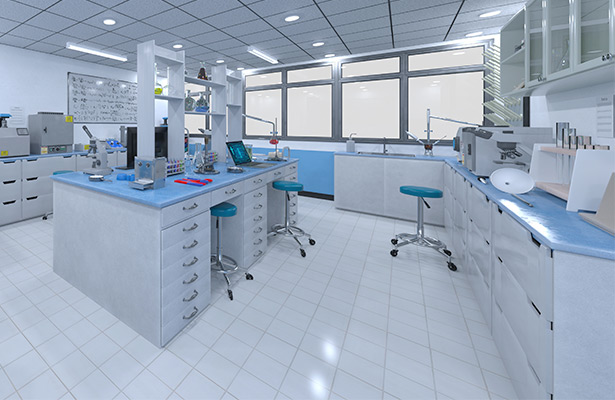

© tsuneomp - stock.adobe.com
Profile wrapping for modular furniture in laboratories
Laminated skirtings and trimmings are common elements of modern laboratory furniture. While primarily having functional purposes, they also need to be visually appealing, and there is a huge variety of shapes and decors on offer. In everyday laboratory environments, these elements are constantly exposed to heat, moisture and cleaning agents. Robust and high-quality lab furniture therefore requires specific adhesive systems.
Skirtings are usually made of particle boards, aluminium, or certain plastics. The decor materials – usually meter goods made of various plastics – are specially designed for use in laboratories. The core material and the decor material are glued together in a wrapping process. A constant demand for faster and more efficient production processes poses new challenges for the adhesive used. Tight radii and sharp edges, in particular, generate high recoil strengths in the decor material. Extremely high initial strength is therefore a key criterion for the adhesive.
We draw on many decades of experience and continuous, ambitious research and development, and work closely with renowned machine manufacturers to develop customized bonding processes that lead to excellent results. Let our engineers help you to optimize your production process. We provide customized adhesive systems and all the related expertise.
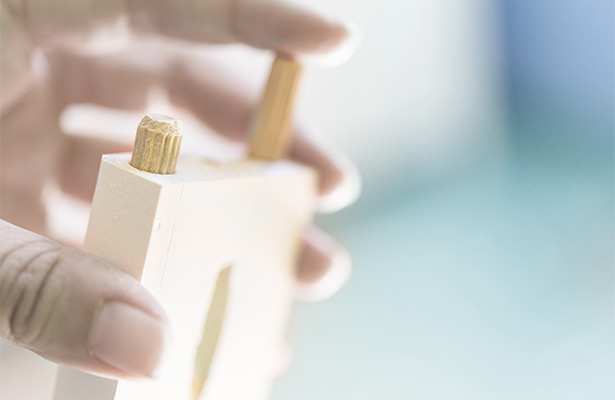

© Laia Divols Escude - stock.adobe.com
Gluing dowels and furniture bodies in laboratories
Automatic dowelling machines are used for machine gluing modular furniture parts together. Depending on the production process specifications, dowel glues with special flow properties are needed. Dowel glues are special PVAc-based dispersions, that are usually applied with injection nozzles. Our dowel glues have a specific formulation that prevents the nozzles clogging during machine idle times.
Would you like a personal consultation?
To the product table & consultation options.
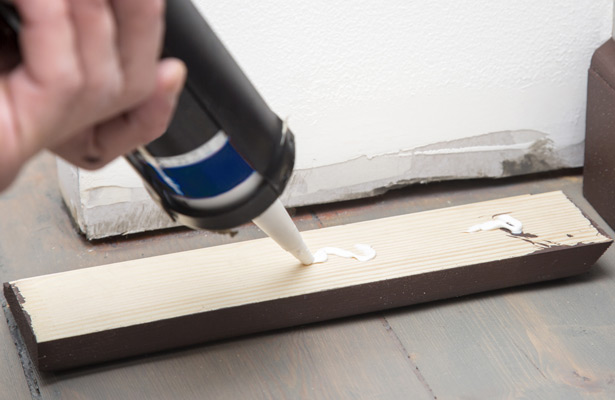

© Ronstik - stock.adobe.com
Assembly bonding in laboratories
Assembly adhesives provide safe and reliable bonding for almost all types of materials. In many cases, they dispense with the need for drilling holes and using screws. Our STP assembly adhesives meet the latest technology standards and are considered to be very low-emission. Our PUR assembly adhesives are equally popular. Both provide easy handling for high-strength bonding.
Browse our web shop for assembly adhesives and the matching applicator guns.
Do you need help with a specific application? Get in touch with us for a personal consultation.
Highlights
KLEIBERIT 601.1 1C STP assembly adhesive
- low-emission
- suitable for natural stone
- stable
- high initial strength
- available in white, beige and black
- very low emission (EC1 plus R) according to EMICODE classification
- emission class A+ according to French VOC regulations
- all types of assembly bonding
- mirror gluing according to DIN EN 1036
KLEIBERIT 601.2 1C STP assembly adhesive
- low-emission
- high initial strength
- very versatile
- very low emission (EC1 plus R) according to EMICODE classification
- emission class A+ according to French VOC regulations
- mirror gluing according to DIN EN 1036
- all types of assembly bonding
KLEIBERIT 601.4 1C STP assembly adhesive
- high initial strength
- suitable for natural stone
- UV and weather resistance
- all types of assembly bonding
- especially for bonds that require high initial strength
KLEIBERIT 707.9.85 Reactive ME BIO hotmelt
- > 35% from non-petrochemical raw materials
- no hazard labeling required, contains renewable raw materials
- versatile edge banding on furniture boards (fronts, rear and base panels, sides)
KLEIBERIT 736.2.00 Reactive hotmelt
- revolutionary, isocyanate-free reactive hotmelt
- sticks to a very wide range of materials
- low processing temperature
- general surface lamination
Dispersion adhesives
KLEIBERIT 332.0.00 Surface/veneer glue
- dispersion adhesive with long open time
- IMO FTP Code Part 5 & Part 2
- surface bonding of laminated panels on wood-based boards
KLEIBERIT 303.0.00 White glue
- dispersion with medium open time (6-10 minutes)
- for waterproof glue joints
- DIN EN 204 D3
- as a two component glue with 5% KLEIBERIT 303.5.00 DIN EN 204 D4
- DIN EN 14257 (Watt 91)
- FDA Guideline 21CFR § 175.105
- dowel gluing
- gluing mortise joints
- gluing furniture bodies
KLEIBERIT 303.5.00 ME Hardener
- hardener components for 303.0, for D4 gluing quality
- increased water resistance
KLEIBERIT 308.0.00 Lacquer glue
- dispersion adhesive for varnished surfaces
- DIN EN 205
- bonding wood-based materials to varnished surfaces
KLEIBERIT 316.0.00 Dowel glue
- non-blocking PVAc dispersion for use with doweling machines with injection nozzles
- knot-sealing machines
- gluing furniture bodies with automatic dowelling machines
KLEIBERIT 347.0.00 PVAc glue
- dispersion with short open time (3-4 mins)
- D2
- IMO FTP Code Part 5 & Part 2
- stationary postforming process, multi-layer molded wood manufacturing, surface lamination, edge banding, furniture body gluing
KLEIBERIT 431.7.00 1C PUR dispersion adhesive
- THE high-gloss expert
- suitable for automated spraying systems
- FIRA certified according to BS 6222 Part 3 1999
- 3D film lamination for high-gloss and thin films
KLEIBERIT 436.3.00 2C PUR dispersion adhesive
- laminating dispersion for temperature-sensitive materials (for deep-drawing)
- 3D film lamination for all standard films, usable with or without a hardener. Very high heat resistance
EVA hotmelts
KLEIBERIT 773.3.00 Hotmelt
- transparent glue joint
- high initial strength
- for high feed rates
- gluing all kinds of standard edging materials
KLEIBERIT 773.8.00 Hotmelt
- for high feed rates
- high initial strength
- also for solid wood and veneer edges
- gluing all kinds of standard edging materials
KLEIBERIT 774.4.00 Hotmelt
- for all standard edge banding materials
- good initial strength
- gluing all kinds of standard edging materials
KLEIBERIT 777.0.00 Hotmelt
- high heat resistance
- gluing all kinds of standard edging materials
KLEIBERIT 779.6 Hotmelt
- also for solid wood and veneer edges
- good initial strength
- available in white, ivory, medium brown and black
- gluing all kinds of standard edging materials
- edge banding with HolzHer machines
KLEIBERIT 782.0 Hotmelt
- HolzHer cartridge
- available in white, ivory, mahogany and black
- edge banding with HolzHer machines
Solvent-based adhesives
KLEIBERIT 261.7.00 Polyester adhesive
- can be applied with doctor blades, fast-drying
- surface lamination of plastic and paper films on wood-based materials
Assembly adhesives
1C PUR assembly adhesive 568.1.00
- all-round adhesive
- vibration-damping
- high-strength bonding, open time approx. 3 mins
- DIN EN 204 D4
- all types of assembly bonding
KLEIBERIT 566.0.00 1C PUR assembly adhesive
- long-term elasticity, re-paintable glue joints, suitable for metal to stone gluing
- IMO FTP Code Part 5 & Part 2
- all types of assembly bonding
KLEIBERIT 568.0.00 1C PUR assembly adhesive
- all-round adhesive
- suitable for glass
- does not foam
- DIN EN 204 D4
- all types of assembly bonding
KLEIBERIT 569.0.00 1C PUR assembly adhesive
- high temperature resistance
- stable on porous substrates
- slightly foaming
- all types of assembly bonding
KLEIBERIT 584.0.00 1C STP adhesive
- long-term elasticity, re-paintable, UV and weather resistant
- all types of assembly bonding
KLEIBERIT 600.0.00 1C STP assembly adhesive
- low-emission, long-term elasticity, transparent
- all types of assembly bonding
- elastic gluing of glass, wood, metal, etc.
KLEIBERIT 601.1 1C STP assembly adhesive
- low-emission
- stable
- high initial strength
- available in white, beige and black
- very low emission (EC1 plus R) according to EMICODE classification
- emission class A+ according to French VOC regulations
- all types of assembly bonding
- mirror gluing according to DIN EN 1036
KLEIBERIT 601.2 1C STP assembly adhesive
- low-emission
- high initial strength
- very versatile
- very low emission (EC1 plus R) according to EMICODE classification
- emission class A+ according to French VOC regulations
- mirror gluing according to DIN EN 1036
- all types of assembly bonding
KLEIBERIT 601.4 1C STP assembly adhesive
- high initial strength
- suitable for natural stone
- UV and weather resistance
- all types of assembly bonding
- especially for bonds that require high initial strength
PO hotmelts
KLEIBERIT 753.5.00 Hotmelt
- high temperature resistance
- suitable for roller, slot nozzle and CNC machines
- straight edges
- postforming
- soft forming
KLEIBERIT 754.1.00 Hotmelt
- for feeding speeds up to 80m/min
- straight edges
- postforming
- soft forming
1C PUR adhesives
KLEIBERIT 501.0.00 1C PUR adhesive
- medium open time
- DIN EN 204 D4
- DIN EN 14257 (Watt 91)
- IMO FTP Code Part 5 & Part 2
- surface bonding of HPL and CPL to wood-based materials
- surface bonding of mineral materials and rigid foams
- surface bonding of laminated panels
- surface bonding of partition elements
KLEIBERIT 501.4.00 1C PUR adhesive
- very short open time
- DIN EN 204 D4
- DIN EN 14257 (Watt 91)
- fast assembly and repair gluing with high temperature and moisture resistance
KLEIBERIT 501.6.00 1C PUR adhesive
- long open time
- DIN EN 204 D4
- DIN EN 14257 (Watt 91)
- surface bonding of laminated panels
- surface bonding of HPL and CPL to wood-based materials
- surface bonding of mineral materials and rigid foams
- manufacturing furniture with high moisture resistance specifications
- gluing frame corners made of all common types of wood for windows
KLEIBERIT 501.8.00 1C PUR adhesive
- short open time
- DIN EN 12765 C4
- DIN EN 14257 (Watt 91)
- DIN EN 204 D4
- manufacturing furniture with high moisture resistance requirements
- surface bonding of HPL and CPL to wood-based materials
- gluing frame corners made of all common types of wood for windows




